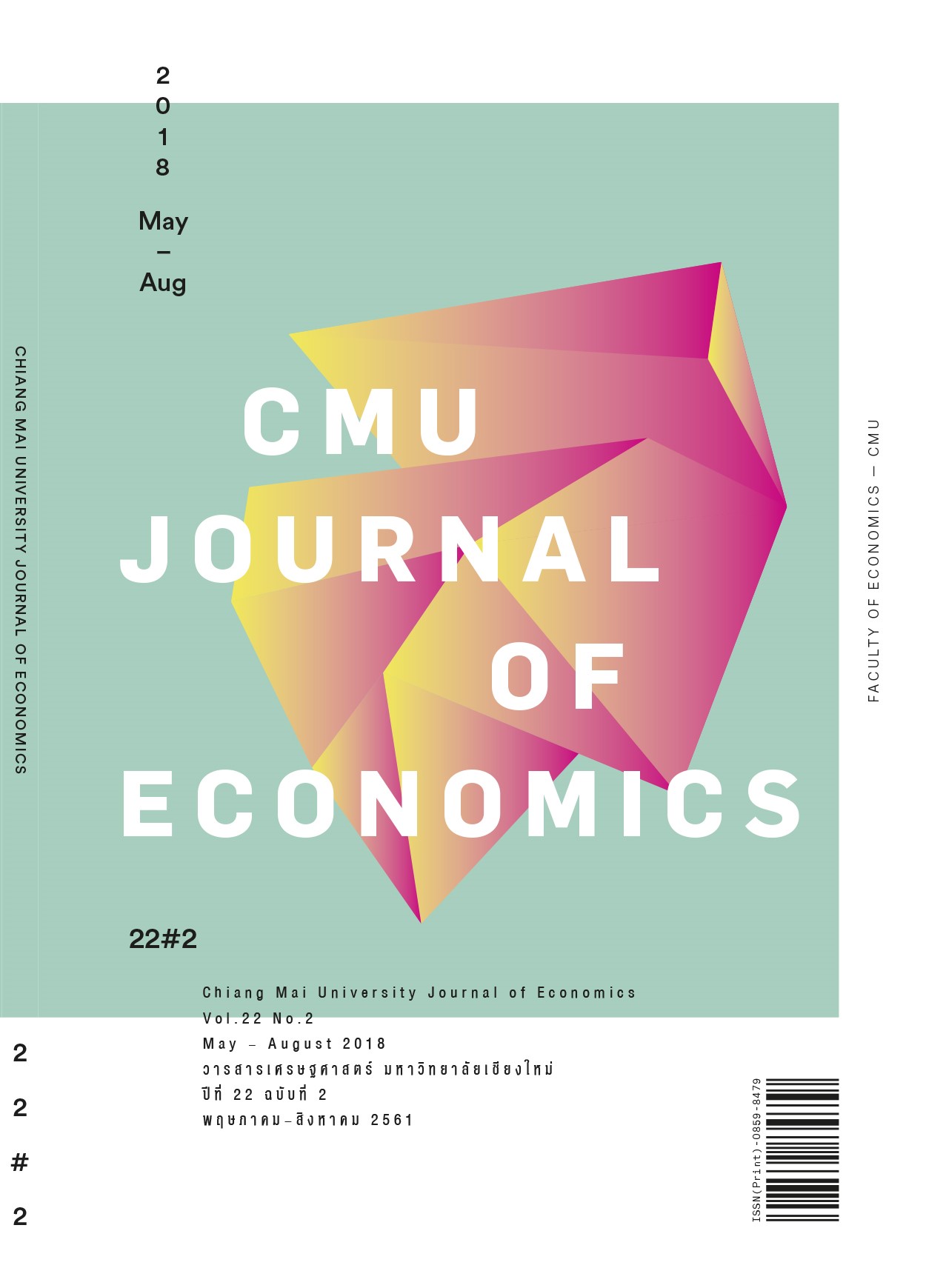Applications Generalized Maximum Entropy Estimators to the Factors Influencing to Determinants of Province Minimum Wage in Thailand: A Case Study
Keywords:
Minimum wage, generalized maximum entropy estimators, linear models, GME, OLS, ค่าจ้างขั้นต่ำ, วิธีเอนโทรปี, แบบจำลองเชิงเส้น, วิธีกำลังสองน้อยที่สุดAbstract
The purpose of this study is to investigate the factors influencing the minimum wage requirements of Krabi, Ranong, Bangkok, Rayong and Saraburi provinces as a case study, where the minimum wage is not adequate to the standard living costs of 2013. The maximum entropy estimation method for linear models (Linear Model) is applied and resulting in the estimation, it is more flexible than Ordinary Least Squares method. In this study, the model error is estimated as Mean Square Error (MSE). The results indicate that the GME method is more appropriate than the least squares method. In addition, the most influence factors are Labor productivity and unemployment, the economic growth rate and the standard living costs in the province, respectively.
การศึกษาครั้งนี้มีวัตถุประสงค์เพื่อศึกษาปัจจัยที่มีผลต่อการกำหนดค่าจ้างขั้นต่ำของจังหวัดกระบี่ ระนอง กรุงเทพ ระยอง และสระบุรี เพื่อใช้เป็นกรณีศึกษาซึ่งเป็นจังหวัดที่ค่าจ้างขั้นต่ำไม่เพียงพอกับค่าใช้จ่ายตามคุณภาพมากที่สุดในปี พ.ศ. 2559 โดยใช้วิธีการประมาณค่าเอนโทรปีสูงสุดสำหรับแบบจำลองเชิงเส้น(Generalized Maximum Entropy Estimators of Linear Model) ซึ่งวิธีนี้มีความยืดหยุ่นกว่าวิธีการประมาณค่าพารามิเตอร์ด้วยวิธีกำลังสองน้อยที่สุด (Ordinary Least Squares) ในการศึกษานี้ประเมินความผิดพลาดของแบบจำลองโดยค่าเฉลี่ยความคลาดเคลื่อน (Mean Square Error :MSE) ผลการศึกษาชี้ให้เห็นว่าวิธีการประมาณค่าเอนโทรปีสูงสุดมีความแม่นยำมากกว่าวิธีกำลังสองน้อยที่สุด นอกจากนี้ยังพบว่าปัจจัยถูกนำมาพิจารณามากที่สุดคือ ผลิตภาพแรงงานและอัตราการว่างงานในจังหวัด รองลงมาคืออัตราการเจริญเติบโตทางเศรษฐกิจในจังหวัดและค่าใช้จ่ายตามคุณภาพ
References
Boonsripracha, C. (1996). Concurrence of Minimum Wage Fixing and Economic Conditions in Thailand. (Master of Science Thesis Economics), Major Field Economics, Department of Economics. Kasetsart University. (in Thai).
Corral, P. and Terbish, M. (2015). Generalized maximum entropy estimation of discrete choice models. Stata Journal, StataCorp LP, 15(2), 512-522.
Corral, P., Kuehn, D and Jabir, E. (2017). Generalized maximum entropy estimation of linear models. Stata Journal, StataCorp LP, 17(1), 240-249.
Department of Labour Protection and Welfare, (2014). Labour Protect Act (No. 3) B.E. 2551. Bangkok: Department of Labour Protection and Welfare. (in Thai).
Eruygur H. O. (2005, May). Generalized maximum entropy (GME) estimator: formulation and a Monte Carlo study. Paper presented at the VII National Symposium on Econometrics and Statistics, Istanbul, Turkey, (pp. 1-17).
Golan, A. (2008). Information and entropy econometrics-a review and synthesis. Foundations and Trends in Econometrics, 2(no 1–2), 1–145.
Golan, A., Judge, G. and Karp, L. (1996, April). A maximum entropy approach to estimation and inference in dynamic models or Counting fish in the sea using maximum entropy. Journal of Economic Dynamics and Control, 20(4), 559-582.
Golan, A., Judge, G. and Miller, D. (1997). The maximum entropy approach to estimation and inference, in Thomas B. Fomby, R. Carter Hill (ed.) Applying Maximum Entropy to Econometric Problems (Advances in Econometrics, Volume 12) Emerald Group Publishing Limited, 3 – 24.
Jaynes, E. T. (1957). Information Theory and Statistical Mechanics. Physics Reviews, 106(4), 620–630.
Jaynes, E. T. (1979). Where do We Stand on Maximum Entropy?. In the Maximum Entropy Formalism, Levine, R. D. and Tribus, M., eds. Cambridge, MA: MIT Press (1979), 115–118.
Junvith, P and Benya-a-pikul, P. (2013). Full report: Research project on the minimum wage for Thailand and impact on the economy. Faculty of Economics. Thammasat University. (in Thai).
Junvith, P. (2011). The evolution of the minimum wage system and the social security system in Thailand. Faculty of Economics, Thammasat University. (in Thai).
Office of the Permanent Secretary. (2005). A study of standard criteria and model for the fixation of the minimum wage in Thailand. TDRI: Thailand Development Research Institute. (in Thai).
Office of the Wage Committee. (2011). Manual operation of the Subcommittee to consider the provincial minimum wage rate. Ministry of Labour. (in Thai).
Office of the Wage Committee. (2017). The result of the survey, the cost of the labor needed to develop the industrial sector in 2559 B.E. Ministry of Labour. (in Thai).
Peetz, D. (1996). Review of Minimum Wage Fixation in Thailand. Bangkok: ILO East Asia Multidisciplinary Advisory Team.
Pholphirul, P. and Rukumnuaykit, P. (2014). Human capital and labor productivity in the industrial sector, Thailand: Final Report. The Thailand Research Fund. (in Thai).
Pukelsheim, F. (1994). The Three Sigma Rule. The American Statistician, 48(2), 88-91. DOI: 10.2307/2684253
Shannon, C. E. (1948). A Mathematical Theory of Communication. The Bell System Technical Journal, (27), 379–423, 623–656.
Sriboochitta, S., Liu, J. and Sirisrisakulchai, J. (2014, May). Willingness-to-pay estimation using generalized maximum-entropy: a case study. International Journal of Approximate Reasoning, (60), 1-7. DOI: 10.1016/j.ijar.2015.02.003
Downloads
Published
Issue
Section
License
All opinions and contents in the CMJE are the responsibility of the author(s). Chiang Mai University Journal of Economics reserves the copyright for all published materials. Papers may not be reproduced in any form without the written permission from Chiang Mai University Journal of Economics.
ข้อคิดเห็นที่ปรากฏและแสดงในเนื้อหาบทความต่างๆในวารสารเศรษฐศาสตร์มหาวิทยาลัยเชียงใหม่ ถือเป็นความเห็นและความรับผิดชอบโดยตรงของผู้เขียนบทความนั้นๆ มิใช่เป็นความเห็นและความรับผิดชอบใดๆของวารสารเศรษฐศาสตร์ มหาวิทยาลัยเชียงใหม่
บทความ เนื้อหา และข้อมูล ฯลฯ ในวารสารเศรษฐศาสตร์มหาวิทยาลัยเชียงใหม่ ถือเป็นลิขสิทธิ์เฉพาะของคณะเศรษฐศาสตร์มหาวิทยาลัยเชียงใหม่ หากบุคคลหรือหน่วยงานใดต้องการนำทั้งหมดหรือส่วนหนึ่งส่วนใดไปเผยแพร่ต่อหรือเพื่อกระทำการใดๆ จะต้องได้รับอนุญาตเป็นลายลักษณ์อักษร จากวารสารเศรษฐศาสตร์ มหาวิทยาลัยเชียงใหม่






